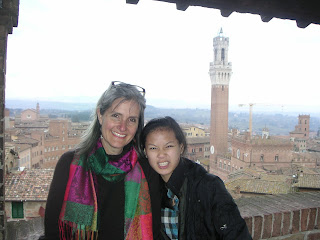Greetings from Italy. We had a wonderful journey to Rome last week. Getting back was a bit exciting as a big snow storm hit the country. and with all the trains and busses out, we ended up spending an extra night there. Back here the snow is still around, the weather is cold, and our hot water and heat are gone- we are having an authentic Italian journey.
One of the primary metaphors I am exploring during this time is that of adoption. Because of the season and the timing of this sabbatical- I want to begin a discussion about adoption talking about Joseph. Not the son of Jacob, but the one who gets oft overlooked in the story and the artwork of Jesus.
The Christmas story is most often about Jesus and Mary, with a few shepherds and wise men thrown in... Very rarely, if ever, does the spotlight shine on Joseph. This week we walked through the most extensive religous art collection in the world at the Vatican Museum. There were numerous scenes of Mary and the baby. Sometimes Joseph was there, but often in the background, or the shadows, never in front.
I have decided that Joseph is really like an offensive lineman- only noticed when they make a mistake. Even though games are won and lost on the line, the glory always goes to the backs. Joseph is a lineman. He labors away under the radar, always working hard, always doing the right thing, and at the end of the play it is Mary and Jesus standing in the endzone doing the touchdown dance.
Lets look at the quiet yet powerful role that Joseph plays. We are introduced to Joseph in Matthew 1:16 as the son of Jacob and the husband of Mary. We hear in vs. 17 that he is engaged to Mary, and we find out that she is now pregnant. We are told that the child is of the Holy Spirit, but Joseph doesn’t know that, yet. He has been humiliated, his beloved fiance in scandal, and look what he does... Her husband Joseph, being a righteous man and unwilling to expose her to public disgrace, planned to dismiss her quietly.
He does not take the right he would have to see her discraced... he goes the high road- you got to like this man.
But right after he has decided to do the right and merciful thing, an angel appears to Joseph in a dream. That is right a dream. This will happen 4 more times that Joseph is visited in a dream, and each time he obeys. That angel directs him to marry Mary and name the child Jesus (He saves) for he will save his people from their sins. So Joseph does what the angel commands...
Luke tells us that a group of Shepherds receive a visit from more angels, and they come to see Jesus. When they arrive they find Jesus in a manger, just as the angels said, and they also see Mary and Joseph. While tradition and art may overlook this good man, the gospel writers don’t.
He then takes care of Mary when she has to give birth in a stable- not the place that any expectant mother imagines having her baby. He makes the best of the situation and they end up using a feed trough as a cradle. Then, after the Magi visit, Joseph is visited again, and he protects his bride, his adopted son and leaves all he knows to go and make a life in Egypt. Joseph does what a good father does.
The in Mt. 2:19 Joseph is visited again in a dream (you got to think he was a bit scared to go to sleep for awhile) and this angel says it is time to return- So he does. The angel comes the 4th time directing him to the area of Galilee. Get this, for the 4th time, Joseph does exactly what the angel directs him, with no thought of his own career or needs. Joseph does what good fathers do, he sacrifices. We don’t notice Joseph, because like a good left tackle, he is doing his job keeping his child safe.
Notice though, while Joseph is clearly not the biological father of Jesus, he is his father. When Jesus begins his ministry, Luke introduces him as such,” Jesus was about thirty years old when he began his work. He was the son (as was thought) of Joseph son of Heli, (Luke 3.25 ) Jesus is from the line of David- that is from Joseph. He is of the tree of Jesse, that is Joseph. The reason Jesus is born in Bethlehem, the city of David, is that Joseph had to go to his own town. Jesus is not from the seed of Joseph, but Joseph treats him as his own son, the neighbors treat his as his son, and the authorities would treat him as a son. Joseph is the picture of a loving adoptive parent.
While we don’t see lots about adoption in the Gospels (we will see much more of it in Paul), we do see adoption in action through Joseph. So this season, as you celebrate with your family, raise a glass of nog to Joseph, and may we all seek to live out a life of humble, quiet obedience and sacrifice that he models.
Ciao and Buon Natale to all and to all a good night...
Doug





